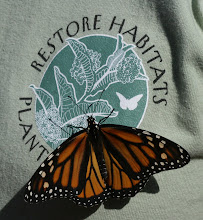Then it was time to climb into Bill's car for the drive to visit some of the monarch overwintering sites in the area. David recently completed a study of the monarch butterfly overwintering habitat at Camp Pendelton. He shared information about his observations and very patiently answered our many questions.
 Monarchs love to roost in Eucalyptus Trees in southern California. Today we watched them fly and tried to follow them to the trees to find other monarchs. David and Leana mentioned that usually they would find only a few monarchs together rather than the large clusters further north. They also said that when there are only males (or 90% males), the roost is likely an autumnal site. A true overwintering site has both male and female monarchs.
Monarchs love to roost in Eucalyptus Trees in southern California. Today we watched them fly and tried to follow them to the trees to find other monarchs. David and Leana mentioned that usually they would find only a few monarchs together rather than the large clusters further north. They also said that when there are only males (or 90% males), the roost is likely an autumnal site. A true overwintering site has both male and female monarchs. The primary nectar source for the overwintering monarchs is the flower of the Eucalyptus Trees that blooms throughout the time the monarchs are there. The trees provide protection from wind and rain with a food source nearby. Despite this ideal arrangement, the monarch population is dwindling in Southern California. The possible reasons are too numerous to list here, but as an example David shared the humidity differences this year compared to one year ago. In 2008 the humidity was 65%. Today it was 25%. The dryer climate and less frequent rains adversely affects the habitat of trees and plants in the area.
The primary nectar source for the overwintering monarchs is the flower of the Eucalyptus Trees that blooms throughout the time the monarchs are there. The trees provide protection from wind and rain with a food source nearby. Despite this ideal arrangement, the monarch population is dwindling in Southern California. The possible reasons are too numerous to list here, but as an example David shared the humidity differences this year compared to one year ago. In 2008 the humidity was 65%. Today it was 25%. The dryer climate and less frequent rains adversely affects the habitat of trees and plants in the area.The numbers of monarchs at the sites we visited were strikingly less than last year. The counts as of today are:

 Although David tried, we were not able to access the San Onofre Creek Site at Camp Pendleton due to security issues. This was the place where two blue Southwest Monarch Study tags were spotted last year. But David, Leana and Bill all promised to look closely for them when they are able to gain entry in the future.
Although David tried, we were not able to access the San Onofre Creek Site at Camp Pendleton due to security issues. This was the place where two blue Southwest Monarch Study tags were spotted last year. But David, Leana and Bill all promised to look closely for them when they are able to gain entry in the future. When we returned to the Monarch Program facility David showed us how to test a monarch for O. E. using clear scotch tape and a microscope. Ophryocystis elektroscirrha (OE) is an protozoan parasite that can infect monarch and queen butterflies. OE must live within a host (in this case a monarch) to grow and multiply. David found in the monarchs he tested at Camp Pendleton that the O.E. infection rate starts low at the beginning of the overwintering season, peaks, then declines at the end of the season.
When we returned to the Monarch Program facility David showed us how to test a monarch for O. E. using clear scotch tape and a microscope. Ophryocystis elektroscirrha (OE) is an protozoan parasite that can infect monarch and queen butterflies. OE must live within a host (in this case a monarch) to grow and multiply. David found in the monarchs he tested at Camp Pendleton that the O.E. infection rate starts low at the beginning of the overwintering season, peaks, then declines at the end of the season.While we didn't spot any blue-tagged monarchs today, it was still a great day!

No comments:
Post a Comment